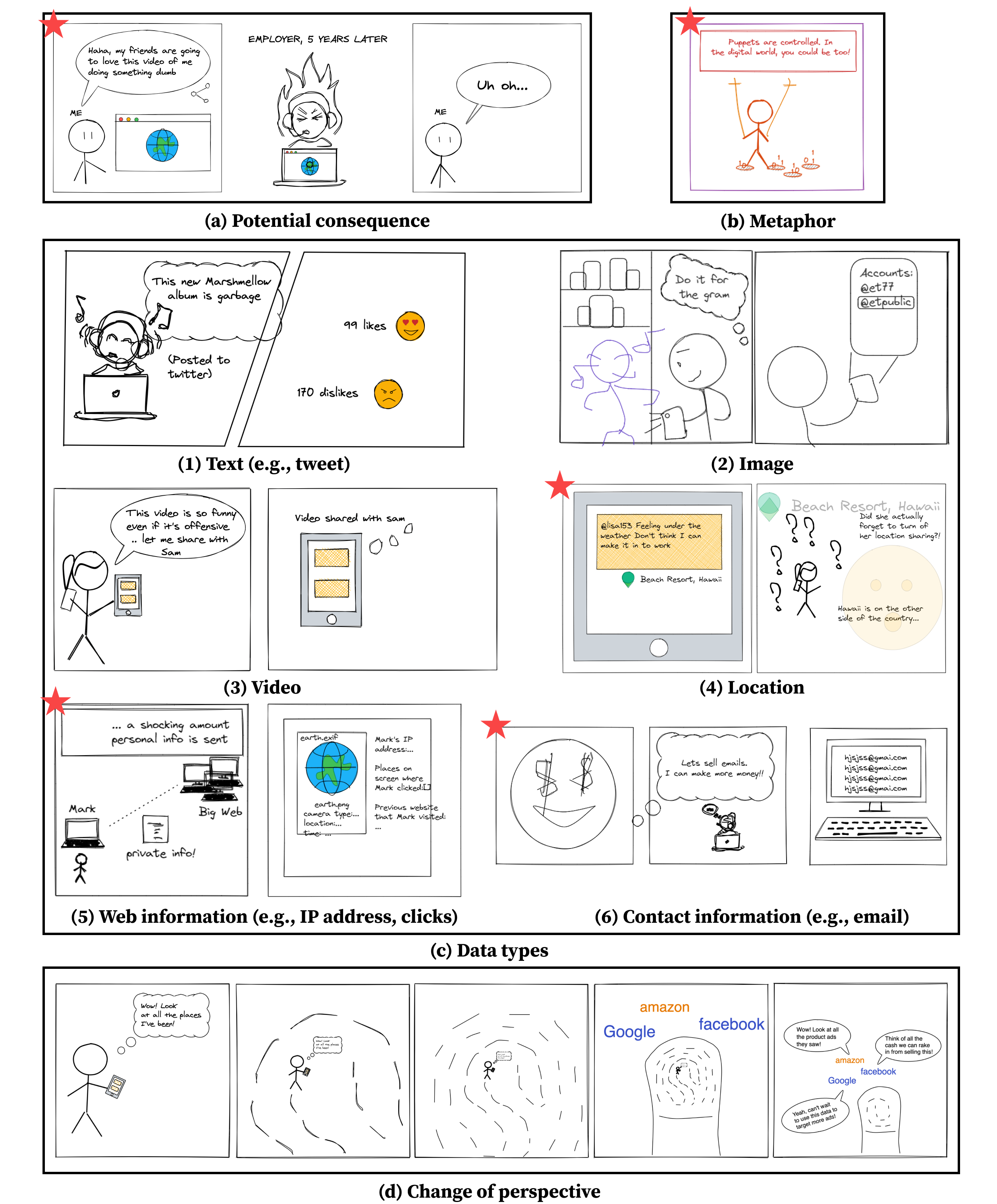PrivacyToon
Concept-driven Storytelling with Creativity Support for Privacy Concepts 🎖

While comics can be an effective medium for communicating privacy concepts, existing privacy and security educational comics do not support content creation. To address this, we developed PrivacyToon, a comic authoring tool that helps users create customizable privacy-related visual content.
Quick Facts
- Teaching appropriate privacy practices and cybersecurity concepts can be challenging.
- Comics has been a popular medium for explaining privacy and cybersecurity concepts.
- With existing tools, however, it is time-consuming and challenging to create educational comics. They are not designed to be customizable to capture evolving threats and new topics of interest. Further, they do not engage users in the creative process of constructing content to communicate and reflect on their understanding of the concepts. ===
- Ideation cards are cards that support ideation tasks, i.e., brainstorming ideas.
- Ideation is a fundamental step in any design process. Over the years, supporting ideation with ideation cards has been one of the most popular forms of creativity support for supporting design processes (e.g.,
).
PrivacyToon
You can watch the tutorial below to see how it works (or try the the system at https://privacytoon.github.io/). For a more detailed breakdown of the system, please see our paper
Methodology
- Derive design goals
based on literature and prior work - Develop PrivacyToon
- Test
its educational and creativity support capabilitiesvia user study
User Study

We conducted a within-subject study with 18 students and 5 teachers. As shown in Fig. 2, the study consisted of the following steps:
- Pre-study survey: Answer questions related to demographics, etc.
- Replication exercise: Get familiar with the drawing tool via replication exercise.
- Task#1 (WITHOUT-CREATIVITY-SUPPORT): Read an article about privacy topic -> Create comic about the topic -> CSI Survey
- Task#2 (WITH-CREATIVITY-SUPPORT): Read an article about privacy topic -> Create comic about the topic -> CSI/Post-Study/Usability Survey
- Exit interview: Elaborate on the authoring process and survey responses.
Preliminary List of Design Dimensions in Privacy Comics
By analyzing 46 comics created from the study, we found various design dimensions for privacy comics (cf. Fig. 4). For detailed explanations of these dimensions, please see our paper.

For More Details
- Paper: https://dl.acm.org/doi/10.1145/3532106.3533557 | https://sanghosuh.github.io/papers/privacytoon.pdf]
- Preview (Video): https://youtu.be/VFF5y8aNceQ
- Talk (Video): https://youtu.be/iWerIttTy88
- Privacy Comics (from our user study): https://privacytoon.github.io/download
Publication
Sangho Suh, Sydney Lamorea, Edith Law, and Leah Zhang-Kennedy. 2022. PrivacyToon: Concept-driven Storytelling with Creativity Support for Privacy Concepts. In Designing Interactive Systems Conference (DIS ‘22). Association for Computing Machinery, New York, NY, USA, 41–57. https://doi.org/10.1145/3532106.3533557
Cite this work
@inproceedings{suh2022privacytoon,
title={PrivacyToon: Concept-driven Storytelling with Creativity Support for Privacy Concepts},
author={Suh, Sangho and Lamorea, Sydney and Law, Edith and Zhang-Kennedy, Leah},
booktitle={Designing Interactive Systems Conference},
pages={41--57},
year={2022}
}